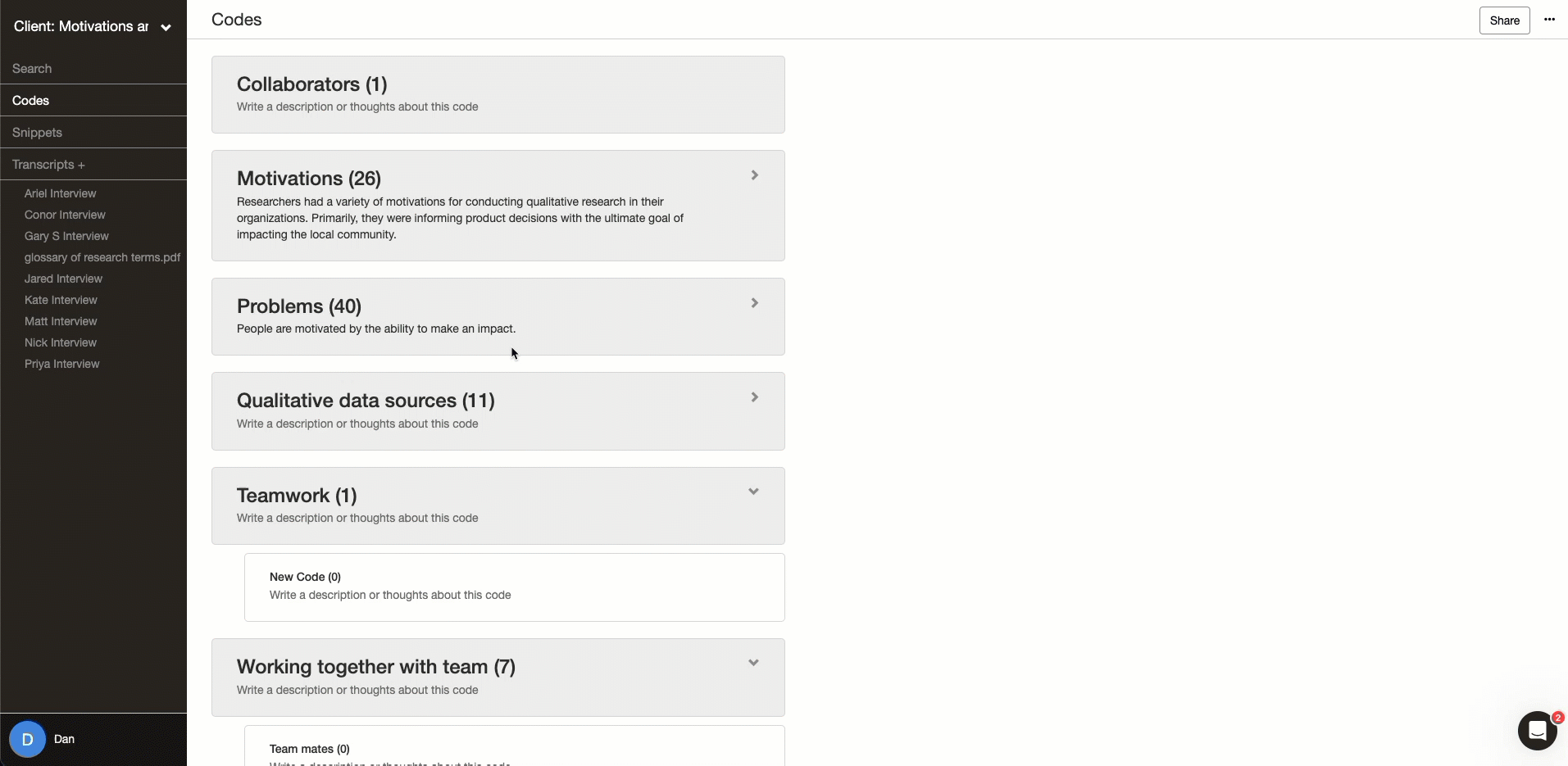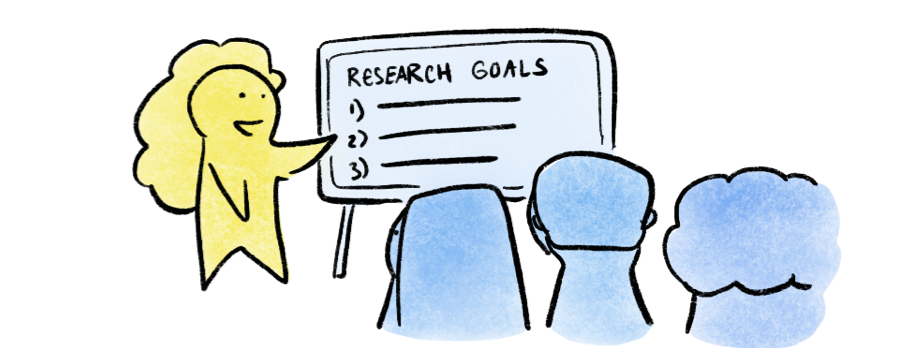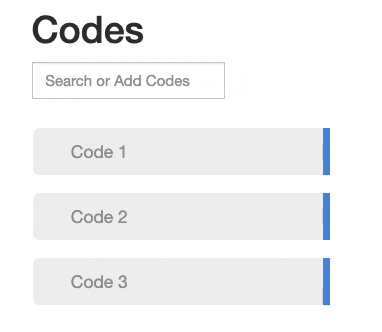How To Do Descriptive Coding in Qualitative Research
You know the insights you need are buried somewhere in your stack of interview transcripts. The hard part is figuring out an orderly way to unpack them. It’s a tall, stressful undertaking, but descriptive coding provides a clear first step to organize and map your data without getting bogged down in every detail.
In this guide, we'll walk through descriptive coding, when to use it, and how to apply it to your research. We'll include practical examples, coding tips, and show how qualitative coding tools like Delve make the process straightforward (even if you’re just starting with qualitative analysis).
📘 New to qualitative coding?
If you're just getting started or want a refresher, our free coding course walks you through the basics. For a deeper dive, check out the qualitative coding guide for hands-on tips and best practices.
Get a lay of the land: What is descriptive coding?
Descriptive coding is a first-cycle method that involves assigning short labels, typically nouns or noun phrases like “home,” “stress,” or “colleagues,” to chunks of your data. These descriptive codes summarize what that segment is about and help you quickly categorize all your qualitative data into general topics. It’s like getting a lay of the land from a bird’s-eye view.
For example, if a participant discusses their morning routine in a study about workplace wellness, you might code that section as "daily habits" or "morning routine." If they talk about struggling with work-life balance, you could label it "work-life boundaries." As you apply these labels, you'll start grouping your data into clear topic areas. This makes it easier to filter and explore related segments later. In your codebook, you list each code, briefly define it, and provide an example for clarity, such as:
"Workplace Equipment": Mentions of office furniture or tools impacting work comfort.
"Daily Habits": Descriptions of routines like morning activities or evening rituals.
"Work-life Boundaries": Statements about challenges balancing professional and personal responsibilities.
Tools like Delve make it easy to apply descriptive codes and build a codebook. It’s as simple as highlighting text and typing a label. This shortens the organizational and administrative parts of your research, letting you focus on discovering meaningful patterns rather than managing your coding system.
Now that you know what descriptive coding is, let's briefly look at how it compares to other first-cycle coding methods.
💡 Not digging too deep is part of the plan
Think of descriptive coding like creating hashtags for your data: #WorkplaceStress, #RemoteWorkChallenges, #TeamDynamics. These topic-based labels help you categorize and find related sections later, creating a foundation for more interpretive analysis.
How is descriptive coding different from other methods?
First-cycle methods like descriptive coding break down your data into initial categories. Second-cycle methods (like pattern coding or axial coding) then reorganize and analyze these initial codes to identify broader themes and relationships. But descriptive coding is different from other first-cycle coding methods in several ways:
Focus on topics, not interpretation: Unlike interpretive coding methods like values coding, descriptive coding doesn't aim to analyze deeper meanings or connections. Just subject matter.
Uses researcher's language: Unlike in vivo coding (which uses participants' exact words), descriptive coding uses your own words to summarize topics.
Think nouns over actions: While process coding highlights actions and verbs with gerunds (-ing words), descriptive coding typically uses nouns (like "workplace," "education," or "family relationships") to label what the content is about.
Different from line-by-line coding: Where line-by-line coding looks at each line of text separately, descriptive coding focuses on conceptual chunks regardless of length.
Other first-cycle methods include emotion coding (labeling feelings) and initial coding (breaking data into discrete parts). You don't need to stick exclusively to descriptive coding—many researchers combine multiple coding methods for even richer analysis. You might use descriptive coding to organize topics while also capturing powerful quotes with in vivo coding and emotional reactions with emotion coding.
So, what makes descriptive coding different is that it focuses on what your data is about, rather than how participants express themselves or what they're doing, believing, or feeling.
Breaking down your data: When to use descriptive coding
Descriptive coding is particularly useful for organizing your data without immediately diving into interpretation. You’re mapping out your data (getting a lay of the land) without getting lost in every single detail or idea, preparing your data for deeper analytical approaches like thematic analysis or grounded theory later on. Here’s when descriptive coding is most helpful:
When you're new to qualitative research - The straightforward nature of descriptive coding makes it accessible for beginners and organizes your thoughts for the rest of your analysis.
When working with different data types - If your research includes varied materials like field notes, interview transcripts, documents, photos, or videos, descriptive coding helps organize them all under consistent topic areas.
For overwhelming datasets - When you facing mountains of data, descriptive coding provides a systematic way to create an organized inventory.
Early in your analysis - To understand your data before moving to more interpretive approaches.
For longitudinal studies - When tracking how topics change over time across multiple research phases.
Remember that qualitative research is inherently iterative. You'll likely move back and forth between descriptive coding, memo-writing, and analysis. Tools like Delve automatically organize your codes and memos so you can easily follow your analytical journey without losing sight of your original data.
💬 What researchers say about Delve
Delve is a go-to tool for researchers who want to stay organized without the usual hassle. Its web-based platform minimizes busywork so you can stay focused on uncovering meaningful insights.

Descriptive coding example and how it works in practice
The best way to understand descriptive coding is to see it in action. Let's walk through a practical example step-by-step, using an excerpt from our workplace wellness study.
Step 1: Familiarize yourself with the data
Start by reading through your entire dataset without coding anything yet. You’re simply getting a feel for the topics and making informal notes on initial impressions. Expect to read your data several times—this iterative approach helps you better understand potential themes before coding begins.
Step 2: Assign descriptive codes
Now, revisit each segment and label it with short, clear codes summarizing its content. Here’s how that might look in Delve:
Physical Activity:
“I try to take short breaks during the day to stretch or walk around. It helps clear my mind when I've been staring at spreadsheets for hours.”Workplace Equipment:
“My company recently started offering standing desks, which has made a huge difference for my back pain.”Office Environment:
“But the office is still really noisy with all the open-plan seating, which makes it hard to focus sometimes.”
With Delve, quickly assigning these codes is easy. All you do is highlight the text, type your labels, and let the tool manage the organization behind the scenes. You can easily filter your codebook by each descriptive category to keep your coding consistent as you build toward a clear, coherent narrative.
🔍 Practical coding tip
Descriptive codes work best when they strike the right balance. "Health" is too broad, while "Tuesday afternoon stretching routine" is too specific. Aim for clear, flexible labels like "Physical activity" or "Workplace wellness" that can group similar content without losing meaning.
Step 3: Maintain a simple descriptive codebook
Now it's time to list your codes clearly, along with brief definitions and examples in your codebook. This helps you stay consistent. If you're working with a team, it keeps everyone aligned without second-guessing what each label means. As you code, it helps to keep short notes or memos to remember why specific segments stood out – and to track ideas over time. A basic codebook might look like this:
Workplace Equipment: Mentions of office furniture or tools impacting work comfort.
Daily Habits: Descriptions of routines like morning activities or evening rituals.
Work-life Boundaries: Statements about challenges balancing professional and personal responsibilities.
You can update, search, and edit your codebook easily in Delve as you go. The web-based software keeps everything organized and ready for the next phase of analysis, whether working solo or with a team.
📝 Stay consistent with memos
As you build your codebook, use short memos to capture why segments stood out and how your thinking evolves. Delve makes it easy to attach memos directly to your codes and revisit them throughout the analysis process.

Step 4: Refine codes as you go
Expect your codes to evolve during analysis. Consolidate or adjust them as needed. For instance, if you notice significant overlap, combine "daily habits" and "morning routines" into a single category. Delve allows you to easily merge or rename codes without losing context.
💡 Qualitative analysis best practice
As you refine your descriptive codes, keep writing short notes and memos to track your thinking. These reflections help capture how your understanding evolves and keep your analysis grounded and clear. Learn more in our guide to analytical memos.
Step 5: Group related codes into broader categories
After coding your dataset, identify connections between codes. For example, "Physical Activity," "Workplace Equipment," and "Office Environment" might all fall under a broader category such as "Workplace Wellness Factors." Grouping your codes this way sets the stage for second-cycle coding.
At this stage, Delve’s co-occurrence matrix feature helps track down any overlapping codes.It visually highlights overlaps between codes, guiding you toward potential themes for deeper analysis. The Code Pages feature also gives you a top-level view of entire coding categories in one place.
Remember, descriptive coding (like most qualitative analysis) is iterative! You’ll move between coding, memo-writing, and interpretation multiple times before reaching deeper insights.
🔎 Streamlined search across transcripts
Instantly find quotes across all your transcripts—no more flipping through pages. Delve’s project-wide search makes it easy to look up keywords or phrases and pull related segments for deeper analysis.

Next Steps: Moving Beyond Descriptive Coding
Descriptive coding provides a clear foundation for understanding your data. From here, you’re ready for deeper analysis using methods like pattern coding, deriving themes in thematic analysis, or axial coding in grounded theory. When you reach these steps, you focus on deeper insights and interpretations.
In the next section, we'll explore some of the usual challenges to expect with descriptive coding and practical strategies for overcoming them without getting overwhelmed.
🔍 Build better descriptive codes
Keep your codes broad enough to group related ideas, but specific enough to be useful. "Health" might be too broad, while "Tuesday morning pre-workout vitamin regimen" is likely too narrow. Aim for middle-ground labels like "Exercise habits" or "Nutrition practices".
Challenges in descriptive coding (And how to overcome them)
While descriptive coding is straightforward, researchers often encounter a few common sticking points when transitioning from initial coding into deeper analysis. Here's how those challenges typically show up—and how coding tools like Delve can help you stay on track:
1. Too many codes to handle
As you go through your data line by line, it’s easy to end up with dozens (or hundreds) of codes that feel slightly different but overlap in meaning. This can make your codebook feel bloated and hard to manage.
Solution: As shown in Step 4, plan to revise and consolidate your codes as you go. Delve’s nesting feature lets you organize related codes hierarchically, so you can group similar ideas without losing detail or cluttering your workspace.
2. Consistent coding is tough
Once you’ve assigned your initial codes, it can be hard to stay consistent. If your dataset is large or you're working across multiple sessions, it’s even harder. Labels like “office environment” and “workspace distractions” might feel interchangeable unless you’ve clearly defined them.
Solution: Step 3 emphasized keeping a clear, simple codebook with examples. In Delve, you can add descriptions to each code and filter your dataset to review how you’ve used them. This, along with the transcript-wide search feature, makes it easier to spot inconsistencies and course-correct as needed.
3. Moving beyond description
Descriptive coding gives you structure, but on its own, it won’t uncover patterns or meanings. If you stop here, you might miss the bigger picture.
Solution: Descriptive coding is your groundwork. Once your topics are mapped, you’re ready to move into second-cycle coding. Features like the co-occurrence matrices highlight where codes overlap, helping you spot important themes and relationships to explore further.
4. Stay grounded in your data with code pages
As you start pulling together insights, it’s easy to lose track of where specific quotes came from—or worse, pull something out of context. Jumping between documents, trying to find the original quote, and manually copy-pasting excerpts can slow you down and introduce errors.
Solution: Delve’s Code Pages help you stay connected to the data. Each code has its own page showing all the excerpts you’ve assigned to it, along with which transcript each quote came from. You can scan patterns, revisit the full context, and use project search for even faster data recall.
5. Managing collaborative coding
When you’re coding with multiple researchers on the same data, maintaining consistent topic identification can be challenging. Measuring intercoder reliability helps you track how consistently your team applies your codebook and where it might be able to improve.
Solution: Establish clear coding protocols and regularly check intercoder reliability. Delve's collaborative features make it easy to compare coding approaches and resolve discrepancies.
Moving on: Turn descriptive codes into meaningful insights
After completing your descriptive coding, you'll have a well-organized inventory of topics in your data. But that's just the beginning of the journey! Here's how to build upon your descriptive coding foundation:
Identify frequency and patterns: Note which topics appear most often or in particular contexts.
Examine relationships: Look for connections between different topic areas using tools like Codes Pages or co-occurrence matrices.
Apply second-cycle coding: Use methods like pattern coding or axial coding to develop themes and concepts from your topic inventory.
Write analytical memos: Document your observations about new patterns and potential meanings throughout the process.
The beauty of starting with descriptive coding is that it gives you a clear roadmap of your data landscape and a blueprint for how to approach the rest of your analytical work.
Start your descriptive coding journey
Descriptive coding offers a practical, accessible entry point into qualitative analysis, especially for researchers just beginning their qualitative journey. By focusing first on what your data is about before diving into deeper interpretations, you create a solid foundation for more nuanced analysis.
Ready to streamline your descriptive coding process? Delve turns hours of manual work into a smooth, efficient coding process without all the stress. Our cloud-based platform also ensures your coding work is safely stored and easily accessible, whether you're working alone or collaborating with a team.
Start your 14-day free trial of Delve today and experience how much easier descriptive coding can be.

Streamline Your Thematic Analysis with Delve | Top-Rated by Researchers ⇒
Rated as a top qualitative coding software on Capterra, Delve simplifies the entire process, making it easier to uncover patterns, collaborate, and produce insights that matter.
Get 14 Days FreeNo commitment. Cancel anytime.
References
Saldaña, J. (2016). The coding manual for qualitative researchers (3rd ed.). SAGE.
Miles, M. B., Huberman, A. M., & Saldaña, J. (2014). Qualitative data analysis: A methods sourcebook (3rd ed.). Sage Publications. https://doi.org/10.1177/239700221402800402
Cite this blog post
Delve, Ho, L., & Limpaecher, A. (2025, April 02). How to Do Descriptive Coding in Qualitative Research. https://delvetool.com/blog/descriptivecoding










